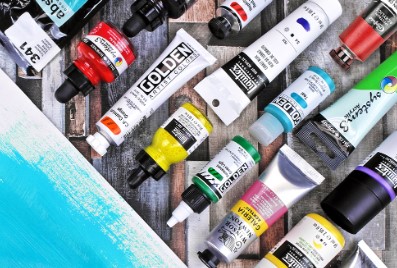Acrylic paints have become an artist’s favourite due to their versatility, quick drying time, and vibrant colours. Whether you’re a beginner or a seasoned artist, selecting the correct type of paint can significantly impact the outcome of your work. A dizzying array of these paints is on the market, but you may narrow your options by learning their distinctions. The right paint will enhance the quality of your artwork and allow you to enjoy a more satisfying creative process.
Choosing the right Acrylic paint is crucial for achieving the desired effects and ensuring your artwork stands out. Different types of acrylics cater to various techniques and styles, making it essential to know which best aligns with your creative vision. Use this handy guide to sort your alternatives and pick the one that best suits your creative demands.
Understanding Viscosity
A colour’s viscosity—its thickness or thinness—determines how it behaves and looks on canvas. Acrylics come in different viscosities, from heavy body to fluid. Heavy bodies are thick and retain brush strokes, making them ideal for impasto techniques and textured surfaces. They are perfect for artists who want to create bold, dynamic textures and layers. On the other hand, fluids are much thinner and flow more easily. They are great for fine details, glazing, and watercolour-like effects. Artists should choose the viscosity that aligns with their desired texture and application style.
Drying Time Considerations
The rapid drying period is a distinguishing feature of this paint. However, not all acrylics dry at the same rate. Standard acrylics dry quickly, allowing artists to layer colours without waiting long. This is beneficial for those who enjoy working at a brisk pace or need to complete projects swiftly. Slow-drying, also known as open acrylics, offers a longer working time, similar to oil colour. This extended drying time allows for more blending and manipulation on the canvas. Artists prefer a more relaxed approach and detailed blending might opt for slow-drying varieties.
Exploring Color Range and Pigmentation
The colour range and pigmentation play a crucial role in the vibrancy and depth of the artwork. High-quality colours are richly pigmented, providing intense colour payoff and excellent coverage. They also offer various colours, including unique shades and hues that can enhance an artist’s palette. Some manufacturers provide speciality colours like iridescent and metallic, adding an extra dimension to the artwork. When choosing acrylic, artists should consider the availability of colours and the intensity of pigmentation to achieve their desired visual effects.
Read also: 10×10 Custom Canopy Tents: Your Manual to a Multipurpose Outdoor Haven
Finish and Surface Sheen
They can produce different finishes, from matte to glossy. The finish affects the overall appearance and feel of the artwork. Matte finishes are non-reflective and offer a subdued look, making them suitable for detailed and realistic paintings. Glossy finishes, on the other hand, are shiny and vibrant, enhancing the colours and adding a sense of depth. Some artists prefer a satin finish, which balances matte and glossy. The choice of finish depends on the artist’s aesthetic preference and the mood they want to convey in their work.
Considering Additional Mediums and Additives
They are versatile; artists can expand their capabilities using mediums and additives. These products can alter the paint’s texture, transparency, and drying time. For instance, a gel medium can increase the paint’s thickness, making it suitable for heavy textures. Glazing mediums can enhance the transparency and luminosity of colours, ideal for layering and glazing techniques. Retarders can slow down the drying time, giving artists more flexibility in blending.
Choosing the right Acrylic paint is essential for bringing your artistic vision to life. These paints offer endless possibilities for creativity, and selecting the appropriate type can significantly enhance an artist’s work. By considering these aspects, artists can find the perfect paint that complements their creative vision and brings their artistic ideas to life.



